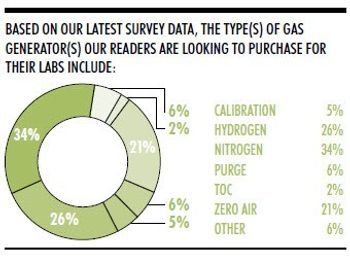
The Future of Low, Medium-Volume Gas Needs
Laboratory gases serve a variety of purposes, from inert barriers for lab operations and instruments to consumption in analytical processes. On-demand gas generators have been around for decades, but the high cost of helium—the one-time gas of choice for gas chromatography mobile phases—has caused many laboratories to reconsider how all their gases are acquired, stored, and used.
Mark Finblay, marketing assistant at Peak Scientific (Inchinnan, Scotland), explains that compared with bulky, heavy, and sometimes dangerous compressed gas cylinders, generators provide numerous advantages. “Gases are generated on demand, when they are required, at the point of use. Generators are safer than cylinders; they never run out and are much more secure and reliable from a supply perspective.” Unlike cylinders, gas generators have onboard alarms for leak detection, which is particularly useful for flammable or explosive gases.
Peak specializes in gas generators for nitrogen, hydrogen, zero air, zero nitrogen, and calibration gases for use in LC, LC-MS, GC, and GC-MS in the foods, pharmaceuticals, environmental, and petrochemical industries.
Scarce resource
The singular event in the adoption of laboratory gas generators has been the helium shortage. Hydrogen is obviously not a suitable replacement for all helium applications—it is, after all, highly flammable, whereas helium is inert. But as Kim Myers, global product manager at Parker Hannifin (Fairfield, NJ), explains, “Hydrogen is a superior GC carrier gas, providing higher resolution [and] shorter run times, at far lower cost.”
Hydrogen is catching on so strongly, Myers says, that users and instrument vendors alike are now writing methods to support hydrogen as a GC carrier gas. “This represents a huge shift,” he adds. “You can’t get hydrogen in some parts of the U.S.”
As for hydrogen’s danger—think the Hindenburg dirigible— quantities used in modern capillary GC columns are minuscule. Because it is manufactured on demand, at low pressures, the need for large-scale storage is obviated and without it, all danger of tank mishaps. “When leaks do occur, gas release is tiny,” Myers tells Lab Manager.
Like most vendors and distributors of laboratory gas generators, Myers estimates rapid payback in replacing helium with hydrogen— between nine and 18 months. “The biggest barrier to adoption is tradition,” he says. “Labs are used to staring at gas tanks delivered to their door. Tanks seem more tangible than boxes that use water to generate hydrogen. Many users believe the performance and payback are too good to be true, but that is changing.”
Read more at Lab Manager Magazine
View our Gas Generators category on LabWrench
